The Uluzzian and Châtelperronian: No Technological Affinity in a Shared Chronological Framework
- PMID: 39764441
- PMCID: PMC11700062
- DOI: 10.1007/s41982-024-00202-1
The Uluzzian and Châtelperronian: No Technological Affinity in a Shared Chronological Framework
Abstract
The Châtelperronian and Uluzzian techno-complexes are identified in western Europe in the same stratigraphic position, between the late Middle Palaeolithic and other Upper Palaeolithic assemblages. Both industries include retouched artefacts with abrupt retouch and arched backs, and radiometric dating indicates that these two technocomplexes belong to the same window of time. Here, we provide a detailed, qualitative technological comparison of two Châtelperronian and two Uluzzian lithic assemblages based on a collaborative, first-hand examination of these collections. This study results from a one-week workshop designed to bring relevant researchers together to conduct an in-person investigation of these lithic industries. Our analysis highlights significant technological divergences between these industries. In short, the Châtelperronian is a blade industry with a minor bladelet component produced by freehand direct percussion, whereas the Uluzzian is a flake-bladelet industry with massive use of bipolar percussion and a minor component produced by freehand, direct percussion. Our results suggest that there are no, or very little, technological affinities between the Châtelperronian and the Uluzzian - despite occupying the same window of time. As an extension, this suggests that there was little to no relationship/contact between the groups producing these industries during the Middle to Upper Palaeolithic transition. The distinctiveness of the Châtelperronian and Uluzzian highlights that technological behaviours in western Europe during the 45-40 ka can be very diverse and that general labels such as 'transitional industries' are unsatisfactory in describing this diversity.
Supplementary information: The online version contains supplementary material available at 10.1007/s41982-024-00202-1.
Keywords: Châtelperronian; Lithic technology; MP-UP transition; Transitional industries; Uluzzian.
© The Author(s) 2025.
Conflict of interest statement
Conflict of InterestThe authors declare no competing interests.
Figures



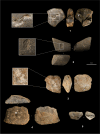
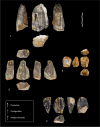
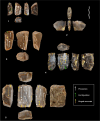
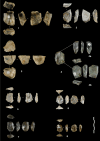
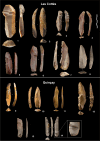
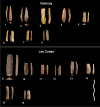


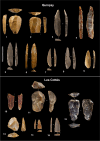



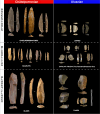
Similar articles
-
The Châtelperronian conundrum: Blade and bladelet lithic technologies from Quinçay, France.J Hum Evol. 2016 Jun;95:13-32. doi: 10.1016/j.jhevol.2016.02.003. Epub 2016 Apr 6. J Hum Evol. 2016. PMID: 27260172
-
On the local Mousterian origin of the Châtelperronian: Integrating typo-technological, chronostratigraphic and contextual data.J Hum Evol. 2015 Sep;86:55-91. doi: 10.1016/j.jhevol.2015.06.011. Epub 2015 Aug 13. J Hum Evol. 2015. PMID: 26277304
-
Grotta del Cavallo (Apulia-Southern Italy). The Uluzzian in the mirror.J Anthropol Sci. 2018 Dec 31;96:125-160. doi: 10.4436/JASS.96004. Epub 2018 Jul 1. J Anthropol Sci. 2018. PMID: 30036183
-
Stratigraphic and technological evidence from the Middle Palaeolithic-Châtelperronian-Aurignacian record at the Bordes-Fitte rockshelter (Roches d'Abilly site, Central France).J Hum Evol. 2012 Jan;62(1):116-37. doi: 10.1016/j.jhevol.2011.10.009. Epub 2011 Dec 10. J Hum Evol. 2012. PMID: 22154424
-
The Uluzzian technology of Grotta di Fumane and its implication for reconstructing cultural dynamics in the Middle-Upper Palaeolithic transition of Western Eurasia.J Hum Evol. 2016 Feb;91:36-56. doi: 10.1016/j.jhevol.2015.10.012. Epub 2015 Dec 17. J Hum Evol. 2016. PMID: 26852812
Cited by
-
Unravelling the influence of mixed layer depth on chlorophyll-a dynamics in the Red Sea.PLoS One. 2025 Mar 5;20(3):e0318214. doi: 10.1371/journal.pone.0318214. eCollection 2025. PLoS One. 2025. PMID: 40043058 Free PMC article.
-
TS-SSA: An improved two-stage sparrow search algorithm for large-scale many-objective optimization problems.PLoS One. 2025 Mar 17;20(3):e0314584. doi: 10.1371/journal.pone.0314584. eCollection 2025. PLoS One. 2025. PMID: 40096191 Free PMC article.
-
New insights from the application of ZooMS to Late Pleistocene fauna from Grotta di Castelcivita, southern Italy.Sci Rep. 2025 Jul 17;15(1):25906. doi: 10.1038/s41598-025-11355-6. Sci Rep. 2025. PMID: 40670577 Free PMC article.
References
-
- Arrighi, S., Moroni, A., Tassoni, L., Boschin, F., Badino, F., Bortolini, E., et al. (2020). Bone tools, ornaments and other unusual objects during the Middle to Upper Palaeolithic transition in Italy. Quaternary International,551, 169–187. 10.1016/j.quaint.2019.11.016
-
- Arrighi, S., Bortolini, E., Tassoni, L., Benocci, A., Manganelli, G., Spagnolo, V., et al. (2020). Backdating systematic shell ornament making in Europe to 45,000 years ago. Archaeological and Anthropological Sciences,12(2), 59. 10.1007/s12520-019-00985-3
-
- Arrighi, S., Marciani, G., Rossini, M., Pereira Santos, M. C., Fiorini, A., Martini, I., et al. (2020). Between the hammerstone and the anvil: Bipolar knapping and other percussive activities in the late Mousterian and the Uluzzian of Grotta di Castelcivita (Italy). Archaeological and Anthropological Sciences,12(11), 271. 10.1007/s12520-020-01216-w
-
- Aubry, T., Dimuccio, L. A., Almeida, M., Buylaert, J. P., Fontana, L., Higham, T., Liard, M., Murray, A. S., Neves, M. J., Peyrouse, J. B., & Walter, B. (2012). Stratigraphic and technological evidence from the middle palaeolithic-Châtelperronian-Aurignacian record at the Bordes-Fitte rockshelter (Roches d’Abilly site, Central France). Journal of Human Evolution,62, 116–137. - PubMed
-
- Aubry, T., Dimuccio, L. A., Buylaert, J. P., Liard, M., Murray, A. S., Thomsen, K. J., & Walter, B. (2014). Middle-to-Upper Palaeolithic site formation processes at the Bordes-Fitte rockshelter (Central France). Journal of Archaeological Science,52, 436–457.
LinkOut - more resources
Full Text Sources
Research Materials
